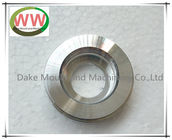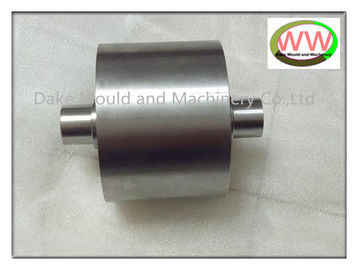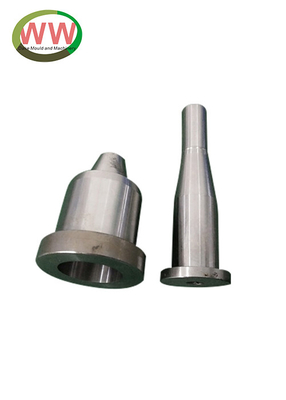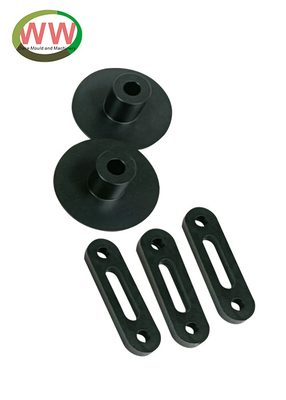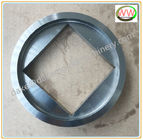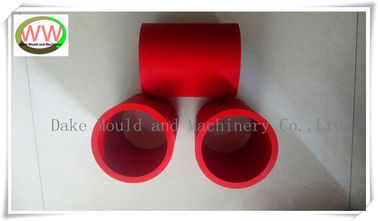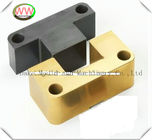CNC precision machining refers to a high-precision machining process using computer numerical control (CNC) technology. CNC stands for "computer numerical control" and is a method of automating processing by controlling machine tools (such as milling machines, lathes, cutting machines, etc.) through computer programs.
Main features
High precision: CNC machining can achieve micron-level processing accuracy and is suitable for parts with strict size and shape requirements.
Automation: The processing process is controlled by computer programs, which reduces human operation errors and improves production efficiency.
Complex shape processing: Able to process complex geometric shapes, suitable for making complex molds and parts.
Consistency: During mass production, CNC machining can maintain product consistency and ensure the same quality for each product.
Flexibility: By modifying the program, production can be quickly adjusted to adapt to different parts processing needs.
Application areas
Aerospace: Used to manufacture key components for aircraft and spacecraft.
Automotive industry: produces engines, chassis and other precision components.
Medical Devices: Manufacturing high-precision medical equipment and instruments.
Electronic products: used in the production of circuit boards and other electronic components.
CNC precision machining plays a vital role in modern manufacturing, meeting the needs of various industries for complex parts with its efficiency and high precision.
How does the cost of CNC machining compare with traditional machining methods?

Compared with traditional processing methods, the cost of CNC processing usually has the following differences:
Cost comparison:
Initial investment:
CNC machining: requires a higher initial investment, including the purchase of CNC machine tools, programming software and related equipment.
Traditional machining: The initial investment is lower, especially the cost of manual machine tools and tools.
Production efficiency:
CNC processing: Due to the high degree of automation, it can complete the processing of complex parts in a short time, suitable for mass production, and the unit cost is relatively low.
Traditional machining: usually requires more manpower and time, especially when processing complex shapes, is less efficient, and the unit cost may be higher.
Labor cost:
CNC processing: Although professional operators are required, the overall labor cost is relatively low due to the automation of the production process.
Traditional machining: requires more manual intervention, especially in complex machining or debugging, and the labor cost is higher.
Material waste:
CNC machining: Often reduces material waste due to high precision and automation.
Traditional machining: May result in higher material waste due to manual operations and low precision.
Maintenance and operation:
CNC machining: Maintenance costs may be higher, but overall operating costs may be lower due to its efficiency.
Traditional machining: Maintenance costs are relatively low, but may result in higher operating costs due to lower efficiency.
Advantages of High Precision CNC Machining
Increased Accuracy and Repeatability
The main difference between standard and precision CNC machining is accuracy. CNC precision machining equipment can run the same set of instructions to achieve tight precision and consistency across batches. This repeatability helps to ensure the production of identical parts in large volumes.
Reduced Waste and Enhanced Efficiency
The optimal tools and parameters maximize the use of raw materials and minimize off-cuts and scrap. Thus, efficient material utilization reduces waste and lowers material costs. Additionally, consistent production quality, faster machining times, and minimal defective items due to automation significantly improve overall production efficiency.
Complex Geometries with Tight Tolerances
Complex parts like turbine blades, custom implants, and molds are also precisely manufacturable using precision machining techniques. The multi-axis capability, computer control of tooling, real-time monitoring & adjustment, and several other features allow for highly complex parts & precision machined products while maintaining tight dimensional precision.
Material Versatility
Adjusting the CNC machining variables and tooling setup allows us to accommodate various materials, from hard titanium grades to soft aluminum and plastics. Moreover, some metals and thermoset composites are also compatible. This large pool of CNC material options facilitates choosing the best-fit material for a particular application needs.
Flexibility in Production
The CNC precision machining techniques, milling, turning, drilling, and EDM, are flexible with the production volume, whether you need a few prototypes or large-scale runs. Consequently, the just-in-time manufacturing strategy can reduce custom parts’ setup, tooling, and machining time.
Overall, CNC machining generally has lower unit costs when used in mass production, especially when producing complex and high-precision parts. However, initial investment and maintenance costs may be higher. Therefore, a specific cost-benefit analysis should be evaluated based on factors such as production scale, part complexity, and market demand. For the production of small batches and simple parts, traditional machining methods may be more cost-effective.
What are the different types of CNC machine tools?

CNC (computer numerical control) machine tools can be divided into various types based on their functions and applications. Here are some common CNC machine types:
CNC milling machine:
Used for cutting and processing metals, plastics and other materials.
Suitable for processing complex shapes.
CNC lathe:
Mainly used for processing cylindrical workpieces.
Cutting is achieved by rotating the workpiece.
CNC laser cutting machine:
The material is cut using a laser beam.
Commonly used for precision cutting of metal, wood and plastic.
CNC Waterjet Cutting Machine:
Material is cut by high-pressure water flow.
Can be used to cut a variety of materials including metal, stone and glass.
CNC Electric Discharge Machine (EDM):
Hard materials are machined by spark discharge.
Suitable for complex shape mold manufacturing.
CNC 3D printer:
Create three-dimensional objects by adding material layer by layer.
Commonly used for prototyping and low-volume production.
CNC engraving machine:
Used for engraving and engraving on wood, plastic and other materials.
Suitable for making art and decorations.
CNC drilling machine:
Mainly used for drilling and reaming.
Suitable for high-precision hole processing.
CNC compound machine tools:
A machine tool that integrates multiple functions and can perform operations such as milling and turning at the same time.
Improve processing efficiency and flexibility.
Different types of CNC machine tools have their own specific application fields and advantages. It is very important to choose the appropriate machine tool according to the specific processing needs.
DAKE-CNC Machining Parts.pdf

What is the future development trend of CNC precision machining?
The future development trend of CNC (computer numerical control) precision machining is mainly reflected in the following aspects:
Automation and intelligence
Smart manufacturing: Integrate Internet of Things (IoT) technology to enable machines to self-monitor and optimize production processes.
Artificial intelligence: Use AI to predict and optimize the processing process to improve accuracy and efficiency.
High-speed and high-precision processing
High-speed processing technology: increase processing speed, shorten production cycle, while maintaining high precision.
Multi-axis machining: Achieve comprehensive processing of complex workpieces and reduce the number of processes and workpiece fixtures.
Application of new materials
Advanced materials: such as composite materials, ultra-light alloys, etc., enhance the adaptability and application scope of CNC processing.
Combining 3D printing: Combining with additive manufacturing technology to expand the flexibility of product design.
Personalized and customized production
Small batch production: Provide personalized customized services based on market demand to improve customer satisfaction.
Flexible manufacturing system: quickly adjust production lines according to different orders.
Green manufacturing
Environmentally friendly materials: Promote the use of recyclable and sustainable materials to reduce waste during processing.
Energy-saving technology: optimize processing technology, reduce energy consumption, and improve resource utilization.
Data-driven and digital transformation
Big data analysis: Optimize production processes and improve decision-making efficiency through data analysis.
Digital twin technology: Create virtual models to simulate and optimize actual production processes.
Education and skills improvement
Technical training: Continuous employee training on new technologies and equipment to improve overall skill levels.
Interdisciplinary collaboration: Combining knowledge from multiple fields such as mechanical engineering and computer science to drive innovation.
The above trends indicate that CNC precision machining will develop in a more intelligent, efficient, environmentally friendly and flexible direction to meet future market needs.
How does CNC technology compare to 3D printing?

CNC technology and 3D printing are both advanced manufacturing processes, but they operate in fundamentally different ways and are suited for different applications. Here’s a comparison of the two:
CNC Technology
Process:
Utilizes subtractive manufacturing, where material is removed from a solid block to create a part.
Involves tools like mills, lathes, and routers that cut away material following a programmed path.
Materials:
Works with a wide range of materials, including metals, plastics, wood, and composites.
Precision and Tolerance:
High precision and tight tolerances, often within thousandths of an inch.
Ideal for parts requiring exact dimensions and surface finishes.
Production Volume:
Suitable for both low and high-volume production.
More efficient for larger production runs due to setup costs.
Applications:
Commonly used in industries like aerospace, automotive, and manufacturing of high-precision components.
3D Printing
Process:
Utilizes additive manufacturing, where material is added layer by layer to build a part from the ground up.
Involves techniques like Fused Deposition Modeling (FDM), Stereolithography (SLA), and Selective Laser Sintering (SLS).
Materials:
Primarily works with plastics, resins, and some metals (especially in advanced 3D printing methods).
Material options are expanding, but still more limited compared to CNC.
Precision and Tolerance:
Generally less precise than CNC, with tolerances that vary based on technology and material.
Surface finish may require post-processing for high-quality applications.
Production Volume:
More cost-effective for low-volume production and prototyping.
Ideal for custom parts and rapid prototyping due to quick setup.
Applications:
Widely used for prototyping, custom parts, medical devices, and complex geometries that are hard to achieve with CNC.
Summary of Key Differences
Manufacturing Type: CNC is subtractive; 3D printing is additive.
Material Versatility: CNC can handle more material types; 3D printing is expanding but still limited.
Precision: CNC generally offers higher precision and tighter tolerances.
Production Scale: CNC is more efficient for larger runs; 3D printing excels in custom or low-volume production.
Both technologies have unique strengths and are often used complementarily in modern manufacturing processes. If you have more specific questions or need further details, feel free to ask!

 Your message must be between 20-3,000 characters!
Your message must be between 20-3,000 characters! Please check your E-mail!
Please check your E-mail!  Your message must be between 20-3,000 characters!
Your message must be between 20-3,000 characters! Please check your E-mail!
Please check your E-mail! 
